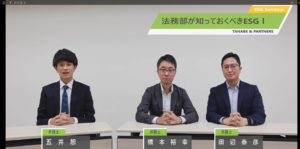
This is the English transcript of the third episode of T&P video series, “ESG Insights for Legal Departments.” If you are interested in, please check the video in Japanese at:
https://www.tanabe-partners.com
Goi: The third episode on “ESG Insights for Legal Departments” delves into the critical notion of “materiality”. Frequently, terms like single materiality and double materiality are heard, but what exactly does “materiality” mean? Moreover, how do these terms—single and double—differ?
Hashimoto: Materiality, essentially synonymous with “importance,” stands as the yardstick for discerning which ESG aspects hold significance. While the concept of single materiality emphasizes the facets crucial to enterprise value and investors among the company’s stakeholders, double materiality broadens the scope to include aspects vital to the natural environment, society, and stakeholders beyond investors. Furthermore, the evolution of these concepts converges into nested or dynamic materiality, signifying the interdependence of these perspectives over time. Ignoring the impacts on the environment and society might initially reduce costs and elevate enterprise value. However, it inevitably leads to long-term repercussions such as legal disputes or business constraints due to resource depletion. Ultimately, both investor priorities and environmental/social concerns converge in one importance over time.
Yasuhiko: T&P’s study group with listed companies focused on understanding SASB standards. This is because, I think, the wide prevalence of GRI standards among Japanese companies showed the needs of different perspective. In fact, I observed a lack of awareness regarding the distinction between single and double materiality. They were receptive, not proactive. For instance, they considered obtaining an ESG rating or being included in an index as sufficient. We should notice that rating agencies sometimes pose risks of opacity and transparency concerns. SASB standards stand out for their clear disclosure rules, fostering transparency. SASB standards are informative for investors as well as issuers. Participants in our study group saw learning SASB standards as beneficial in managing ESG risks and preparing for disclosure in upcoming business ventures.
Goi: How should companies determine material topics relevant to their operations? Is there an ideal number of such topics for a company to disclose? There’s a perception that a higher number of material topics indicates a proactive ESG stance.
Yasuhiko: The selection of material topics necessitates deliberate consideration by each company. SASB, for instance, provides a materiality map specific to each industry, identifying material topics, defined by experts through open and vigorous procedures. Deviating from this map when choosing material topics might raise questions about disclosure integrity unless accompanied by a clear rationale. The number of material topics varies across industries—some may have around five, while others might exceed ten. Quantity doesn’t equate to quality. ESG encompasses both opportunities and risks; it’s crucial to note that while some topics may present opportunities, others may highlight potential risks. More disclosed items don’t necessarily signify a better stance.
Hashimoto: GRI adopts a framework where companies select and disclose items pertinent to them from among the candidate material topics outlined in the standards. This process, known as due diligence, resembles taking inventory of a company’s sustainability-related risks and opportunities. In our study group, insights from investors well-versed in ESG investing regarding their material and topic selection were invaluable. Material topics for a company mustn’t be based on whim or solely on theory, but based on reality and on stakeholder engagements. Particularly in GRI’s case, the focus leans toward the impact on the environment and society rather than just enterprise value. A prime example is the current spotlight on critical issues in business and human rights—a consideration that demands utmost caution.
Goi: The material topic selection isn’t within the purview of the Legal Department. Is the concept of materiality linked to laws and regulations? Are there specific considerations for the Legal Department?
Hashimoto: Consider, for instance, Article 197, Paragraph 1, Item 1, a penalty provision under the Financial Instruments and Exchange Act. This provision entails penalties for furnishing securities reports containing false information regarding “important matters”. The interpretation of “important matters” in relation to materiality impacts this provision’s application. In case of falsehoods in a securities report concerning a topic, which identified “material” by the company, arguing that “this isn’t crucial to investors’ decision-making, thus not constituting a false statement crime” might be challenging. Presently, applying false statement charges to sustainability-related disclosures in securities reports isn’t anticipated to be overly stringent. Nevertheless, Legal Departments should consider disclosure risks and the attainment of responsible disclosure.
Goi: This discussion enlightens us on the concept of “materiality”. Thank you.
